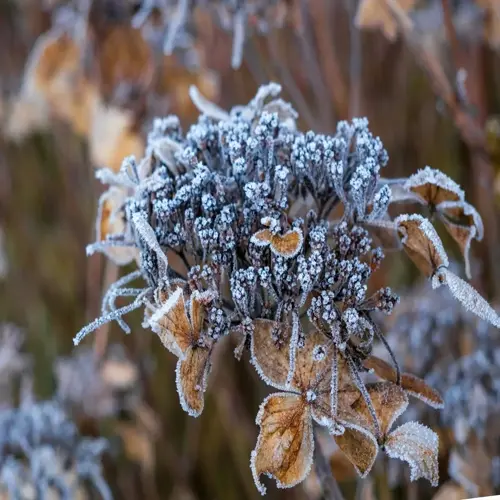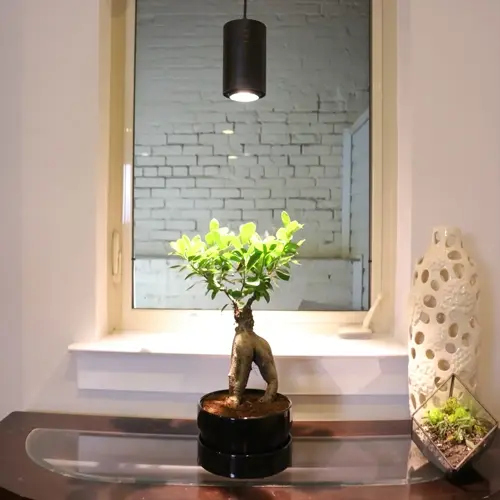Indoor Plant Lighting Essentials Explained

Written by
Olivia Mitchell
Reviewed by
Prof. Samuel Fitzgerald, Ph.D.In terms of indoor plants growing, light is important for photosynthesis and healthy plant growth indoors
LED grow lights can give full spectrum lighting while maximizing energy saving and meaning low heat
Always, they should be placed 6-24 inches away, depending on the lighting requirements of the plant and the phase of growth
While the PPFD intensity levels may range on individual plant types, generally low light (50-250 μmol/m²/s) to high light (>600 μmol/m²/s) is productive with artificial lighting
Common erroneous activities here will be due to light distance from the plant, neglecting the lighting spectrum, and improper timing schedules
When measuring light intensity and adjusting in consideration of the full spectrum of artificial lighting, it is a proper substitute for sunlight.
Article Navigation
Grasping indoor plant lighting is key to plant health. Light fuels photosynthesis, enabling plants to produce food. Without sufficient light, plants will struggle to thrive indoors. When you get this right, it enables you to provide healthy conditions for both lush and struggling plants. We will cover how to assess natural light properly.
You will learn about the various types of artificial lighting suitable for different environments and how to pair plants with optimal lighting conditions for optimal success. This guide helps new growers identify the common mistakes of illumination. Seasoned growers will learn new approaches to ensure plant vitality and health. Now let's get started on transforming your space and growing your thriving green friends into their happy place.
Grow Light Types Compared
The grow light you choose will impact the health of your plants and the amount of electricity you pay for. LED lights can convert 90% of energy to light compared with fluorescents, which can convert only 40%. This matters for both electric cost savings and your gardening results. Full-spectrum LEDs closely replicate the sun's spectrum better than any other type of grow light.
For home growers, the SANSI bulb allows for balanced light without heavy installations. The commercial environment will rely on powerful systems, such as the Spider Farmer SE series. These options provide the specific wavelengths that plants require for photosynthesis. Avoid incandescent bulbs, which waste energy as excessive heat.
Heat control is crucial for indoor gardens. LEDs stay cool and protect fragile leaves. Fluorescents leak some heat, so keep spacing rational. Incandescents must be ventilated or their heat can scorch leaves. Always consider your plants' requirements and your space limitations when selecting the appropriate lamp.
Setup and Placement Guide
Maintaining a proper distance from the light source prevents leggy plants and foliage from burning. For new seedlings, keep the light 4-6 inches (10-15 cm) above them for a good start. Foliage plants thrive at heights of 12-24 inches (30-60 cm). High-light herbs need to be placed 6-12 inches (15-30 cm) away from the light.
Seasonal variation creates lighting adjustments. In winter, move plants closer to windows (6-8 inches, 15-20 cm) and increase the duration of light by 4 hours. Use sheer curtains to filter strong sunlight in summer. Use reflective material (such as Mylar panels) to enhance lighting efficiency and increase light output by 20-30%.
Timers allow for uniform light periods. Foliage plants should be set to 12-16 hours of light per day. Seedlings need about 16-18 hours to initiate consistent growth. Flowering plants, such as poinsettias, require less than 12 hours of smart plug management to optimize power consumption during periods of low utility power.
Distance Guidelines
- Seedlings: Position lights 4-6 inches (10-15 cm) above plants for strong, compact growth without stretching.
- Foliage Plants: Maintain 12-24 inches (30-60 cm) from light source to prevent leaf burn while ensuring sufficient intensity.
- High-Light Plants: Place 6-12 inches (15-30 cm) under LEDs to meet high photosynthetic demands of herbs and citrus.
- Adjustment Rule: Increase distance by 2-4 inches (5-10 cm) every week as plants mature to avoid light stress.
Timing and Automation
- Daily Duration: Provide 12-16 hours of light for foliage plants using programmable timers for consistent daily cycles.
- Seedling Requirements: Extend to 16-18 hours during early growth stages to support rapid root development.
- Photoperiod Sensitivity: Adjust schedules seasonally for flowering plants like poinsettias needing <12 hours.
- Energy Efficiency: Use smart plugs to reduce electricity consumption during off-peak utility hours.
Light Enhancement Techniques
- Reflective Surfaces: Install white walls or Mylar panels to increase light efficiency by 20-30% through photon redirection.
- Light Angling: Position fixtures at 45° angles to cover dense canopies evenly and eliminate shadow zones.
- Space Optimization: Rotate plants weekly to ensure all sides receive equal light distribution for balanced growth.
- Intensity Adjustment: Use dimmable LEDs to gradually increase brightness as plants acclimate to new positions.
Seasonal Adjustments
- Winter Protocol: Move plants 6-8 inches (15-20 cm) closer to windows and add 4 extra artificial light hours daily.
- Summer Precautions: Install sheer curtains to filter intense midday sun and prevent temperature-related leaf scorch.
- Humidity Control: Maintain 40-60% humidity near lights using pebble trays to offset drying effects in heated rooms.
- Ventilation Needs: Ensure 2-4 inches (5-10 cm) clearance around fixtures to dissipate heat during warmer months.
Troubleshooting Placement Issues
- Leggy Growth Response: Reduce light distance by 25% and increase duration by 2 hours when stems appear elongated.
- Leaf Scorch Action: Immediately increase distance by 4-6 inches (10-15 cm) if brown crispy edges develop.
- Uneven Growth Correction: Implement weekly 90° plant rotations and add side lighting for fuller canopy development.
- Color Fading Solution: Measure PPFD levels and supplement with full-spectrum LEDs if pigments appear washed out.
Plant Lighting Needs by Type
Plants require a certain PPFD range in micromol per square meter per second. For very low light plants like Chinese Evergreen, 10-50 μmol/m²/s is ideal; Snake Plants prefer a range of 50-250 μmol/m²/s. Medium-light varieties, such as Monstera, require a range of 250-450 μmol/m²/s. If you have low-light plants, place the light 12 to 24 inches away.
High-light plants such as Basil and Lavender require 450-600 μmol/m²/s. Position them 6-12 inches away from LEDs for 14-16 hours a day. Very high-light plants, such as citrus and Peppers, require 600+ μmol/m²/s with a 4-8 inch distance. Watch for stress symptoms, such as pale leaves in plants grown in low light.
Every category features its own unique distress signals. For Snake Plants or ZZ Plants, if you see more leggy growth than usual, your amount of light is inadequate. For Basil and Ficus, if you see too much bleaching on leaves, you have too much intensity. Rotate your pairing weekly for uniform exposure. The proposed times should be adjusted to best fit each plant, rather than approaching with a one-size-fits-all manner.
Low Light Plants
- Watering Frequency: Reduce watering by 30-50% compared to brighter conditions
- Light Stress Indicators: Leggy growth with wide spacing between leaves, loss of variegation
- Supplemental Lighting: Add full-spectrum LEDs at 18-24 inches if light <50 μmol/m²/s
- Common Issues: Overwatering susceptibility; use well-draining soil mixes
- Plant Examples: Snake Plant, ZZ Plant, Pothos, Cast Iron Plant, Boston Fern
Medium Light Plants
- Watering Frequency: Water when top 1-2 inches of soil are dry (7-10 days)
- Light Stress Indicators: Fading leaf colors, slowed new leaf production
- Supplemental Lighting: Use LED bars for 4-6 extra hours during winter months
- Common Issues: Uneven growth; rotate plants 90° weekly
- Plant Examples: Monstera, Philodendron, Spider Plant, Peace Lily, Moth Orchid
High Light Plants
- Watering Frequency: Water every 3-5 days; check soil moisture daily
- Light Stress Indicators: Leaf bleaching, crispy edges on new growth
- Supplemental Lighting: Position LEDs 6-12 inches above canopy
- Common Issues: Nutrient deficiencies; fertilize every 4-6 weeks during growing season
- Plant Examples: Basil, Lavender, Ficus, Coleus, Begonia
Very Low Light Plants
- Watering Frequency: Water sparingly every 14-21 days as growth is extremely slow
- Light Stress Indicators: Complete cessation of growth, leaf drop without replacement
- Supplemental Lighting: Add low-intensity LEDs at 24+ inches for 10 hours if no natural light
- Common Issues: Root rot from overwatering; use moisture meters to monitor soil dryness
- Plant Examples: Maidenhair Fern, Lucky Bamboo, Aspidistra, Moss Ball, Chinese Evergreen
Very High Light Plants
- Watering Frequency: Daily monitoring; water when top inch is dry
- Light Stress Indicators: Scorched patches, bleached leaves, stunted growth
- Supplemental Lighting: Use high-intensity LEDs (e.g., SANSI 70W) 4-8 inches above plants
- Common Issues: Heat stress; maintain 75-85°F (24-29°C) with good airflow
- Plant Examples: Cacti, Citrus Trees, Tomatoes, Peppers, Rosemary
Common Mistakes to Avoid
Common issues arise from placing lights too close or far away. Leggy growth is the result of lights being too far away, while leaf scorch indicates lights are too close. Generally, starting at a distance of 12-18 inches for foliage-type plants is a good guideline. For any grow light, measure for PPFD to maintain the intensity of 250-450 μmol/m²/s. Adjustable hanging fixtures will help you avoid these issues.
Failing to consider the light spectrum will result in pale foliage and inadequate flowering. Red/blue-only LED light strips do not provide the necessary green light wavelengths. Use full-spectrum lights that include bulbs with a wavelength range of 400-700nm. Always check the spectral charts before purchasing to ensure the marketed lights are suitable for your needs. This will help to avoid tall, long stems and fading color in sensitive specimens.
Applying inconsistent lighting schedules to plants can cause leaf drop, which is especially stressful. Consider setting an automated timer to provide 12-16-hour photoperiods reliably and pretending to increase the photoperiod by 4 hours during the winter months. Smart plugs with appliance sunrise simulations can help promote regular cycles. Various plants can be rotated every week to absorb drainage from different light cycles.
Incorrect Light Distance
- Symptom: Leggy growth or leaf scorch
- Cause: Lights placed too far (>24 inches) or too close (<6 inches)
- Fix: Adjust to 12-18 inches for foliage plants; measure PPFD to verify 250-450 μmol/m²/s
- Prevention: Use hanging adjustable fixtures and light meters
Ignoring Light Spectrum
- Symptom: Pale leaves or lack of flowering
- Cause: Using red/blue-only LEDs missing green spectrum
- Fix: Switch to full-spectrum LEDs covering 400-700nm PAR range
- Prevention: Verify spectral charts before purchase
Inconsistent Photoperiod
- Symptom: Dropping leaves or stalled growth
- Cause: Irregular on/off cycles without timers
- Fix: Set consistent 12-16 hour schedules using smart plugs
- Prevention: Automate lighting with sunrise/sunset simulations
Neglecting Seasonal Changes
- Symptom: Winter decline or summer scorch
- Cause: Static lighting year-round
- Fix: Increase light by 4 hours in winter; add shading in summer
- Prevention: Adjust setups quarterly using solstice reminders
Overlooking Light Distribution
- Symptom: One-sided growth or leaning plants
- Cause: Single-direction light sources
- Fix: Rotate plants 90° weekly; add reflective panels
- Prevention: Use multi-directional bar-style LEDs
5 Common Myths
Many believe all indoor plants require direct sunlight exposure to thrive, but this ignores shade-tolerant species
Most houseplants originate from forest understories where they receive filtered light, making them well-adapted to indirect lighting conditions. Plants like snake plants and pothos actually suffer leaf scorch when exposed to direct sun, preferring 50-250 mol/m/s PPFD levels instead. Measure your light intensity with a meter and supplement with full-spectrum LEDs when natural light is insufficient.
There's a popular myth that artificial light cannot adequately replace sunlight for photosynthesis and growth
Full-spectrum LED grow lights mimic the full 400-700nm PAR spectrum of sunlight and support photosynthesis at every stage of growth. The best growing LEDs, such as Samsung LM301H diodes, effectively pull in 2.9 mol/J making it easy for herbs and vegetables to thrive indoors. To achieve optimal results, it's important to observe the plant species' intensity (PPFD) and photoperiod (14-16 hours per day).
Increasing light might not always speed up growth and can lead to photoinhibition damage
When plants receive more light than they tolerate, photoinhibition occurs, leading chlorophyll to break down and leaves to become bleached or have brownish scorch marks. Each plant species has an optimal range of PPFD, for example, cacti prefer >600 umol/m/s where as ferns do best with 50-250 umol/m/s. So, always adapt the light intensity to the plant in an adjustable fixture and use an inexpensive light meter, or cell phone app, to prevent damage.
Red and blue LEDs will work well for all stages of plant growth
Plants will use green light (500-600nm) for penetrating deeper into their leaves, and the longer wavelength far red (700-800nm) can stimulate flowering responses which are typically absent from primary red/blue LEDs. Full-spectrum white LEDs provide more balanced wavelengths than pure red/blue LEDs, preventing them from getting too tall and pale. If you wish your plants to grow healthier, you should select lights that deliver the full PAR (200 - 3000nm) or use a spectrum distribution chart to verify what your lights do: red, blue, and far-red!
Filtered window light is often underestimated and considered insufficient for proper plant development
South-facing windows deliver 500-1000+ mol/m/s PPFD, adequate for most medium-light plants like monsteras and philodendrons. Use the hand-test method: if your hand casts a clear shadow, light intensity suffices for many species. Only supplement when measurements fall below a plant's minimum requirement, typically below 50 mol/m/s for low-light varieties.
Conclusion
When it comes to designing interior plant lights, there are three crucial principles to follow. The light intensity in PPFD (Photosynthetic Photon Flux Density) should meet the needs of your plant. Spectrum quality ensures balanced growth from root to leaf to flower. Duration regulates the light cycles for photosynthesis (you don't want your plants to suffer from too many cycles). This provides the transition from surviving to thriving.
Begin with low-light plants, such as snake plants or Pothos. First, evaluate your space using the hand-test method. Your hand will need to be placed above the plant, in full daylight. No shadow means adequate natural light. If you still want to supplement, wait until a hazy or blurred shadow appears.
Your booming indoor garden is just steps away. Regulate intensity by season. Use spectrums for growth stages, and control duration with smart timers to standardize time. Your plants will flourish with your experienced hand. Start now.
External Sources
Frequently Asked Questions
What type of lighting works best for indoor plants?
Full-spectrum LED grow lights are ideal as they replicate natural sunlight wavelengths between 400-700nm PAR. These energy-efficient options support all growth stages while producing minimal heat. Position them at proper distances according to plant needs.
Can regular LED bulbs help plants grow indoors?
Standard household LEDs lack the necessary spectrum intensity for proper photosynthesis. Plants require specific blue and red wavelengths within the PAR range. While they provide some light, dedicated full-spectrum grow lights deliver optimal results.
How do I know if my plants get enough light?
Healthy plants maintain vibrant colors and steady growth patterns. Signs of insufficient light include leggy stems, small leaves, and loss of variegation. Use the hand shadow test: a clear shadow indicates adequate intensity.
Can too much artificial light harm indoor plants?
Excessive light causes photobleaching where leaves develop bleached patches. Other symptoms include curled edges and crispy brown spots. Always match PPFD intensity to specific plant requirements and provide daily darkness periods.
Do plants require complete darkness at night?
Yes, darkness enables critical respiration processes. Most plants need uninterrupted darkness for proper growth cycles. Continuous light disrupts natural rhythms, causing stress and poor development.
How close should grow lights be to plants?
Optimal distances vary by plant type and light intensity. Seedlings need 4-6 inches, foliage plants 12-24 inches, and light-loving species 6-12 inches. Monitor for stress signs and adjust accordingly.
What are signs of improper lighting conditions?
Watch for these key indicators:
- Leggy growth: Insufficient light intensity
- Leaf scorch: Lights too close or intense
- Faded colors: Wrong light spectrum
- Stunted growth: Inconsistent photoperiods
Can plants thrive without any natural sunlight?
Yes, with properly configured full-spectrum grow lights. Select appropriate species and maintain consistent lighting schedules. Reflective surfaces enhance efficiency in windowless spaces.
Why do plants need specific light colors?
Different wavelengths trigger distinct growth responses. Blue light promotes foliage while red stimulates flowering. Full-spectrum lights provide balanced nutrition for all development stages.
How long should grow lights remain on daily?
Duration depends on plant type:
- Low-light plants: 10-14 hours
- Foliage plants: 12-16 hours
- Fruiting plants: 14-18 hours
- Always include 6+ hours of darkness

